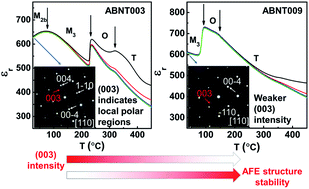Investigation of transitions between the M-phases in AgNbO3 based ceramics†
Abstract
Ceramics based on AgNbO3 show field-induced phase transitions from antiferroelectric (AFE) to ferroelectric (FE) phases which are of interest for high power energy storage in dielectric capacitors. AgNbO3 shows complex phase behaviour, with the so-called M-phases showing little obvious differences in average structure, but significant differences in electrical behaviour. Here, through an A-/B-site co-doping approach, in the system Ag(1−3x)BixNb0.8Ta0.2O3, we stabilise at room temperature the M3 phase and the M2 phase above the dipole freezing temperature (Tf); the latter we designate here as M2b to distinguish it from the phase below Tf (M2a). Investigations of dielectric and structural behaviour reveal that both M2b and M3 phases are AFE in nature, with an average structure that can be described in the orthorhombic space group Pbcm. However, local polar regions, which are evidenced by transmission electron microscopy, can be observed within the AFE matrix in both M2b and M3 phases. Within the M-phases, the AFE phase becomes increasingly more stable towards the field-induced AFE → FE transition in the order M1 < M2a < M2b < M3, which can be attributed to the relative extent of local polar regions in each of the phases.



 Please wait while we load your content...
Please wait while we load your content...